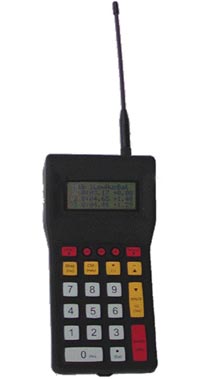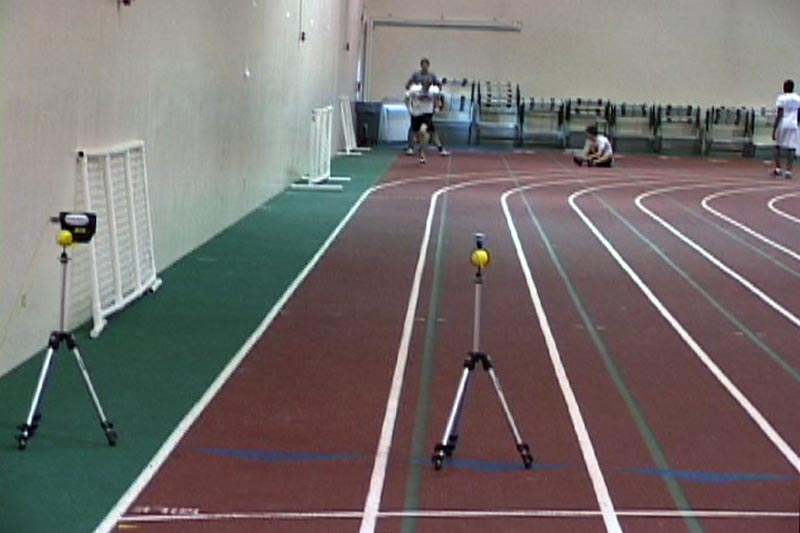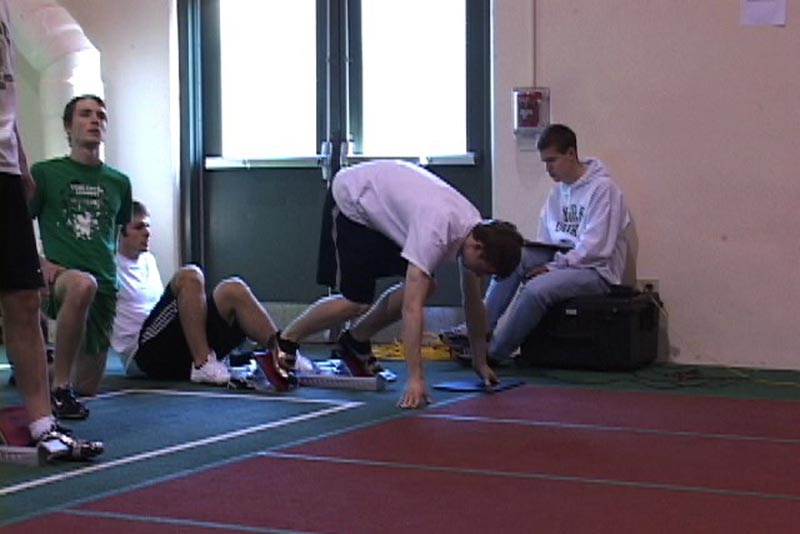
The best assistant coach a track coach can have is an electronic timer. An electronic timer doesn’t lie or cheat. He makes athletes and coaches deal with reality. He tracks athletes’ progress. He motivates without talking. He solves team problems. His only downfall can be reliability.
I found all of these facts out when I started to use a timer in 2001. Timing with a stop watch was not giving me the feedback that I needed to chart my runner’s progress. Meets that were timed with students and parents holding a stop watch were inconsistent. Weather in a Chicago spring was never helpful as well. Running fly’s with a string with a handkerchief tied to it didn’t work either (stand at the finish line and when the handkerchief falls, start the clock). Video could work, but the process was very slow and lacked the instant feedback that creates Flow inside of an athlete. All of these circumstances created a very frustrated coach.
So, catalog shopping, here I come. I bought the wireless Brower Speed Trap II, which had poor stands and radio transmitter. That had lasted a couple of weeks before it started having major problems. Timing indoors with a radio setup was not effective. Waves bounced everywhere and getting a time was about a 50/50 chance. From there, I tested the wired Brower Speed Trap I. It was improved and more consistent but one beam broke, and it took forever to get it back. The beams were also difficult to line up indoors. It was picky about the color of shirts athletes wore when running. It must have been the lighting in the field house. It was time for a major upgrade and investment.
The best assistant coach a track coach can have is an electronic timer. An electronic timer doesn’t lie or cheat. He makes athletes and coaches deal with reality.
I started looking at systems that they used to time skiing. I figured the equipment had to be accurate and durable, the two most important attributes of a timing system. I look at Tag-Hauer, Lynx and Optojump. I thought Optojump could offer the most information but the dollar was way too low to the Euro and I didn’t know what kind of customer service I would get (the third most important factor in a timing system and something non-existent in Brower). I finally talked to someone who knew exactly what I wanted and understood what I needed. Fred at Phoenix sports said he could get me two Alge beams and hard wire them together. He thought the Alge timing system would be too much computer for what I needed and sent me to Ernie at Summit Timing. Ernie custom built a timer that could do flys and starts as he built a touch pad for athletes to put their hand on. The system came in a Pelican case. The beams came with heavy duty stands that have endured everything except getting hit by a car or a freshman girl running into it like it was a suicide mission. Ernie made a heavy duty cable that has been spiked and still worked with easy to change banana plugs. It has been dependable and accurate. When something is wrong, Ernie is a phone call away, and Fred will get you a new beam in 24 hours while he fixes the broken one. Now, this all comes at a price. I think my machine totaled out to $4000.

Figure 1: Summit Timing System
Was it worth it? Absolutely. There is not a more effective training program for speed than running through beams in my opinion. With electronic timing, athletes will always run the best that they can. And if they don’t, you can figure out who doesn’t want to be there. Nothing builds speed like running at top speed. A race will bring out a 100% output, and “training” is less than that. But with timing, I can create that environment more often. Athletes will run at top speed more than once a week and distances that focus on top speed, 10-30’s. With these distances and times, it creates my line-up. My top 4 times on the flys are my 4×1 and 4×2. My top 2 block 30 guys are my 55/100. My top curve/block runner is my lead leg in 4×1 and 4×2. If an athlete is not improving, it is time to figure out why. Is it me or him? Am I overtraining him or is his form off? Each athlete is different and responds differently. One of my best sprinters made the most progress by running flys on Monday (the basis for all of my workouts) and nothing else to the meet. He ran faster every workout in his flys. If he did anything more, he ran slower. His best fly 10 was a 0.968. In this case, the ends justify the means.
Flying Sprints
So, how do I use my system? Some of the methods are pretty simple, but one has changed my relays. Flys are the most obvious use of the laser timing systems. They scream top end speed development. I have read people argue that it is difficult to develop, but I would disagree. Most athletes have never learned to get to top end speed and the ones that have it lose that gear from doing too much long sprint work. That is why flys are the basis of my workouts. A sprinter will only be as fast as his top end speed. Or any runner for that matter. I have had low 4 min 1600 guys who could run 1.09 fly 10. Athletes that have run 47 in 400 were all sub 1.0 in the fly 10. I have not had a great 400m runner who has run slower than 1.04 seconds.

Figure 2: Alge Laser Timing Gate
We start the season with fly 10’s for about 3-5 weeks and build up from there, always cycling back to a fly 10. I increase the distance when we start to stagnate or if it gets warm outside and we can go out. Very rarely does this happen in Chicago. I don’t measure the run up distance. I think Tony Holler does. I should. It would give more validation to my testing. Once outside, we will vary runs with and against the wind and will do some repeat fly 30’s for speed endurance. Run a fly jog back and repeat. Once a runner slows to a certain threshold, we stop. We also run flys on a curve. Except for the 100, half the race is on a curve, so we practice it. We don’t do this indoors. It tends to lead to injury unless you have the technique down (another article, another time).
Accelerations from Starting Blocks

Figure 3: Block Start with Wired Touch Pad
Indoor season we will run flys on Monday and do acceleration work on Wednesdays that is block work. As with the fly’s, this is a timed event. We can make changes in foot placement and short strides or long strides and see what works for each runner. One runner may do well with a Ben Johnson start where another does the John Smith head drop or the Jamaican drag. We can find that out in a highly competitive environment. And like with flys, most of our races start on a curve, and it is the perfect scenario to see who runs the best curve. I usually take this one out to 60m whereas indoor we run 30m on a straight.
Timing the Relay Exchange Zone
Lastly, I use the electronic timing with exchanges. It is a very powerful tool. It takes the guess work out of the exchange. Let’s say that realistically, we want to run a 45.0 4×1 (it makes the math easy). Take 1 second away for the start, and I know everyone needs to run 11.0 fly. The distance I will measure is 30m. That gives me my distance and speed. From there, I can figure out how fast the baton needs to travel through the 30m segment which also happens to be the length of the acceleration and exchange zone. As the incoming runner will start his run, the outgoing runner will be just inside the beam. When the incoming runner hits the take-off mark, the outgoing runner leaves. Incoming runner starts the clock and makes the exchange. From that point, he will veer out of his lane so the outgoing runner will stop the clock when he passes the beam. From there, we can adjust the take-off mark. Move the mark back to give the outgoing runner more time to accelerate or move it forward if they are missing. It also gives the runners the sense that it is really about moving the baton and not how many steps you need. Even more importantly is that you are giving the athlete’s the sense that they are perfect. Practice in different wind conditions so they can see how important making adjustments can be as well. That has been effective in the 4×2 and 4×4 as well. Although I use a radar gun to get the proper speed for those and then practice the exchanges. 21 mph for the 4×2 and 18 mph for the 4×4 is usually the ball park. I usually time their speed at the end of the race during the season, so I know how fast they need to be.
I am about to learn the new Freelap timing system and see what I can do with that as well. Regardless of the system you have, electronic timing is an incredibly effective coaching tool.
Please share this article so others may benefit.
[mashshare]


When the laser was out it was always a competition between the guys. I also thought it made practice more fun and enjoyable.
This method pushed us to work harder to find out better results! Great reinforcement and determinant for times and improvement!
I haven’t been able to purchase to electronic timing equipment yet. But just the idea of timing and keeping track of any of this stuff I think is very important. As Coach Holler says “RECORD, RANK & PUBLISH”.
Even with hand times at practice, once those are put in a spreadsheet and put up in the weight room or on my classroom door, the kids get competitive, make bets with each other,etc…generally push themselves more. It even helps recruit kids out that are just curious what their own time might be.
I’ve heard several coaches who never even write down what their athletes do in a typical practice. Maybe just time trials. What a shame.